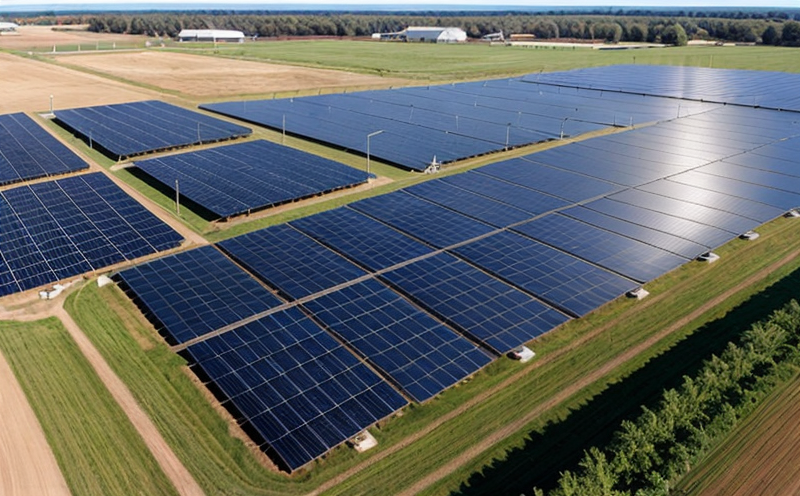EN 50549 Grid Compliance Testing for Distributed Energy Resources
The EN 50549 standard is pivotal in ensuring that distributed energy resources (DERs) such as solar photovoltaic systems, wind turbines, and battery storage units operate seamlessly within the grid. This test evaluates how DERs integrate with the existing electrical infrastructure to ensure reliability, stability, and compliance with safety regulations.
Compliance testing under EN 50549 is not merely a regulatory requirement; it’s an essential step in promoting sustainable energy systems that enhance grid resilience. As renewable technologies evolve, so too must our standards for ensuring their safe and efficient integration into the grid. The scope of this test extends beyond basic performance metrics to include the DER's ability to withstand various operational scenarios while maintaining stability.
Test parameters are meticulously defined in EN 50549 to simulate real-world conditions under which DERs will operate. These include voltage and frequency variations, fault ride-through capabilities, and power quality issues such as harmonic distortion. The testing apparatus includes sophisticated instrumentation capable of measuring minute changes in system performance.
Specimen preparation for this test involves not only the actual hardware but also software configurations to ensure compatibility with grid protocols. This comprehensive approach ensures that DERs are not just installed correctly but function optimally within the grid environment. Reporting from these tests is detailed and includes compliance metrics, identified areas of improvement, and recommendations for enhancing performance.
Our laboratory adheres strictly to international standards such as EN 50549, ASTM D7899, and IEEE Std 1547-2018. These guidelines provide a robust framework for evaluating DERs, ensuring that the tests are both rigorous and relevant. By leveraging these standards, we can offer clients assurance that their systems meet the highest industry benchmarks.
Customer impact is significant as compliance testing ensures reliability and safety in energy delivery. It also supports sustainable energy policies by promoting the use of renewable resources without compromising grid stability. For quality managers and R&D engineers, this service provides critical data for continuous improvement and innovation within DER design.
- Enhanced Grid Stability: Ensures that DERs do not destabilize the grid during peak usage or fault conditions.
- Increased Reliability: Identifies potential issues early, reducing downtime and maintenance costs.
- Safety Assurance: Guarantees adherence to safety regulations, protecting public health and property.
- Policy Compliance: Ensures that DERs meet regulatory requirements for sustainable energy policies.
- Market Access: Provides a competitive edge by ensuring compliance with international standards.
The process begins with an initial consultation to understand the specific needs of each client. This is followed by detailed preparation of the test plan, which includes selecting appropriate instrumentation and defining the operational scenarios for testing. Once the tests are conducted, we provide comprehensive reports that detail all findings and recommendations for improvement.
Quality and Reliability Assurance
Quality assurance in EN 50549 grid compliance testing is paramount to ensuring consistent performance of DERs across different environments. Our laboratory employs advanced methodologies and state-of-the-art equipment to conduct these tests, guaranteeing precision and accuracy.
The process starts with thorough inspection and calibration of all instrumentation used during the test. This ensures that measurements are reliable and can be trusted as a basis for decision-making. Calibration is performed using certified reference standards that align with international norms such as ISO 9001:2015.
During testing, our team closely monitors performance indicators to detect any deviations from expected outcomes. These metrics include voltage regulation, active and reactive power control, and harmonic distortion levels. Any anomalies are documented immediately for further analysis.
Achieving reliability assurance involves rigorous quality checks throughout the test cycle. This includes periodic re-calibration of instruments and validation of test protocols against established standards. Our laboratory maintains strict adherence to these procedures to ensure consistent results across multiple tests.
Quality and reliability are not just words but actions that we take seriously. By maintaining high standards in every aspect of our testing, we provide clients with confidence in the performance and longevity of their DERs.
Customer Impact and Satisfaction
International Acceptance and Recognition
The international recognition of EN 50549 grid compliance testing underscores its importance in the global renewable energy sector. Compliance with this standard is increasingly becoming a prerequisite for market entry in many countries around the world.
Many nations have adopted or are considering adopting EN 50549 to ensure that DERs meet high safety and performance standards. This international acceptance reflects a shared commitment to fostering a reliable, resilient, and sustainable grid infrastructure. By adhering to this standard, we contribute to the global effort towards renewable energy integration.
The widespread use of EN 50549 in various countries highlights its relevance not only within Europe but also in other regions where renewable technologies are rapidly expanding. This international recognition provides a level playing field for manufacturers and operators of DERs, ensuring that they meet consistent standards regardless of geographic location.





